|
|
 |
Archive for January, 2013
Friday, January 25th, 2013
Coral Rock by Amaya
Location of Coral Rock by Amaya
Coral Rock by Amaya is located at 100km south of Colombo at the beach resort town of Hikkaduwa of the south-western coastal belt. Further 15km down south is located the UNESCO World heritage site of VOC Galle Dutch Fort.
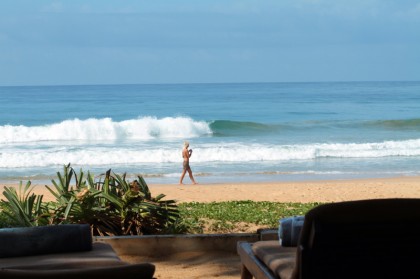
Setting of Coral Rock by Amaya
Beachfront: in a narrow strip of land with Indian Ocean to the west and Colombo – Galle A2 coastal road on one side and the sea on the other.
Sri Lanka Holidays Sustainable tourism (Green i.e., eco) credentials of Coral Rock by Amaya: to be edited
Type of hotel & star rating of Coral Rock by Amaya: a four-star luxury boutique resort
Architecture and Interior Décor of Coral Rock by Amaya:
Coral Rock by Amaya, a luxury boutique resort features antique detailing and modern amenities.
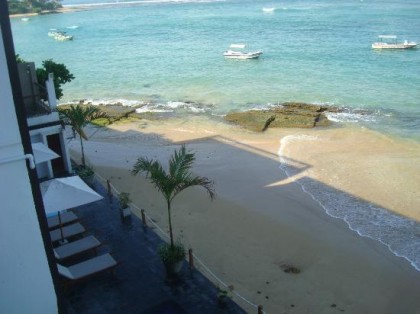
Accomodation at Coral Rock by Amaya
Coral Rock by Amaya consists of 32 air-conditioned rooms with most of those bringing in sea-views. En-suite bathrooms are equipped with hot and cold water head showers.
Superior Rooms: The 14 Superior Rooms brings in the tropical greenery of the land side. Four of the Superior Rooms with interconnecting rooms are ideal for families.
Deluxe Rooms: 14 rooms have private balconies with sea views. Two rooms built on the ground floor have private terraces overlooking the beach.
Super Deluxe Rooms: two spacious Super Deluxe Rooms with sea views suit well for families.
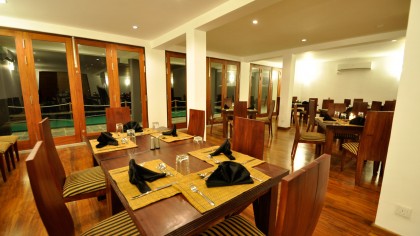
Restaurants and bars at Coral Rock by Amaya
The main restaurant that accommodates 75 guests. The Master Chef well supported by a culinary team serves international cuisine as well as local cuisine.
Lobby bar: a range of alcoholic beverages are available at the lobby bar.
In-room facilities at Coral Rock by Amaya
Entertainment: 32 inch flat screen TVs with satellite channels, wi-fi internet, tea/coffee facility, mini-bar, safe,
Bed and bath: Extra bed, baby crib, extra blankets and towels on request
Internet facilities: Wi-Fi Internet Access
Amenities: tea/coffee facility, mini-bar, safe
Services: room service, 24 hour laundry service, daily housekeeping
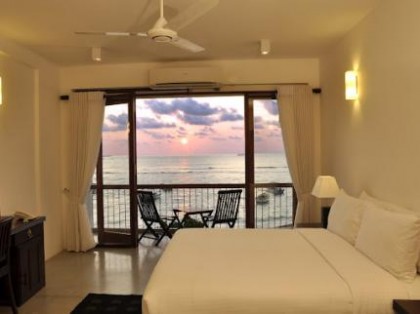
Leisure and recreation at Coral Rock by Amaya
Full length swimming pool
Surfing, diving and deep sea fishing
Boat rides in a glass bottom boat to enjoy to sight of corals
Swimming in the sea right in front of the hotel isn’t advised in view of the coral reef. However, beginning with a short stroll on the beach from the hotel, there unravels a long stretches of fine beaches for safe swimming.
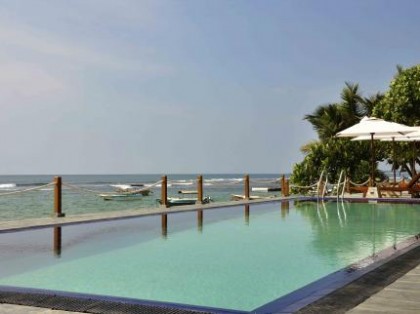
Excursions off Coral Rock by Amaya
Hikkaduwa beach: water sports including surfing, windsurfing, diving oncoral reef.
Bentota beach, lagoon and river: boat safari in the river Bentara ganga and jet skiing, waterskiing in Bentota lagoon
Kosgoda beach: Kosgoda Marine Turtle Conservation Project
Galle sea port: 17th century VOC Galle Dutch Fort, a UNESCO-protected World Heritage Site, the main Sri Lanka Holidays colonial attraction.
Tags: Beach Hotels, Hikkaduwa, Sri Lanka Holidays
Posted in AMAYA RESORTS, Hikkaduwa | No Comments »
Wednesday, January 23rd, 2013
Two main forms of Black tea in consumption
High quality loose leaf Black tea packed in metal containers comes in two forms: pure teas & blended teas. Paper sachets of Black tea, popularly called tea bags (one bag for cup) packed in light cardboard cartons aren’t for those who love high quality Black tea.
 Ceylon Tea Plantations in Kandy, Sri Lanka Blended Black tea
Blended Black tea is precisely what the name carries with it: a blend of Black teas grown & manufactured in different areas of the world. Low quality Kenyan Black tea is often blended with Ceylon tea, the finest tea in the world. If you go for high quality stuff in life, such blends aren’t what you would enjoy.
Then again there are high quality blended Black teas marketed by the blenders by blending Black teas from Sri Lanka (Ceylon tea-finest tea in the world) & Assam of India. Assam of India produces high quality Black tea too. You would definitely go for the blend of Ceylon tea & Assam tea if you like superior stuff.
 Ceylon Tea Plantations in the Central Highlands of Sri Lanka Pure Black tea
Pure Black tea is plucked in the same country. Then again, you could have a tin container of Pure Ceylon tea with its metal printed label indicating it’s a blend. Very true, that’s definitely a blend, but with the unmistakable Lion logo of Ceylon tea, there’s no need for you to get upset. You have just bought a blend of Ceylon teas grown and manufactured in different parts of the island of Sri Lanka exclusively. You are someone who would go for nothing less than The Real McCoy.
Blended Ceylon tea brings off the best in the distinctive flavors & aromas of all the teas involved in the blend. The concept would a ring a bell: Blended Scotch Whisky.
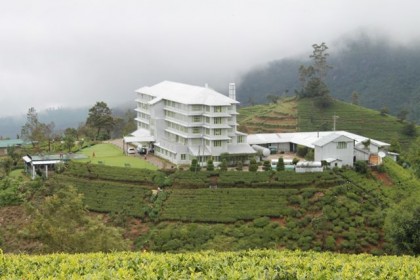 Formerly a Ceylon Tea Factory at Nuwara Eliya, now a Sri Lanka Holidays Luxury Tourist Hotel. Black tea branding by the region of origin
Flavor, aroma & quality of Black teas, as in the case of wine, vary on the climatic & geographic conditions of the area of cultivation. Pure Ceylon teas grown & manufactured at different elevations in the beautiful tropical island of Sri Lanka are called after the area: Nuwara Eliya (2000 meters above sea level), a Sri Lanka Holidays tourist destination, Dimbula (1200-1700m), Uva (1000-1700m), Uda Pussellawa (1200m), Sri Lanka Holidays attraction of Kandy (650-1300 m), Ruhuna (sea level to 600m) each have its own distinctive taste & aroma.
Among the varieties of Black tea from all tea producing countries, quality & popularity of Ceylon tea from Nuwara Eliya, Sri Lanka is akin to the standing of Champagne among wine.
High quality Black teas are grown & manufactured in Indian provinces of Darjeeling, Assam, and Nilgiri too are known by their respective provinces of cultivation & manufacture.
High Grown Ceylon tea, Medium Grown Ceylon tea & Low Grown Ceylon Tea from Sri Lanka
Sri Lanka’s tea plantations are mainly located in the Central Highlands of the island stretching from Kandy of Mediterranean climate to Nuwara Eliya of salubrious climate. Black tea is grown in Ruhuna of Sri Lanka too. Dimbula, Uva, Nuwara Eliya & Uda Pussellawa of higher altitude produce High Grown Ceylon teas of Sri Lanka. While Black tea produced in Kandy [a Sri Lanka Holidays Tourist Attraction] is called Middle Grown Ceylon tea, Black tea produced in Ruhuna is called Low Grown Ceylon tea.
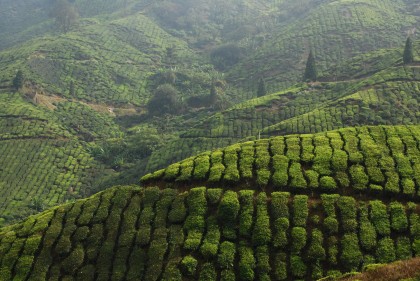 Ceylon Tea Plantation, Central Highlands, Sri Lanka Ceylon tea: Black tea to suit every pallet
Sri Lanka’s production of varieties of Black teas to go with every pallet has been the hallmark of Ceylon tea, the Black tea industry of Sri Lanka. Dimbula & Nuwara Eliya teas are sought after by blenders from all over the world; Uva Black teas too are used for high quality blends mainly in West Germany & Japan; medium grown Ceylon tea is popular in Europe, Australia, Japan & North America; low grown Ceylon tea from Sri Lanka is popular in Western Asia & Middle Eastern countries.
Black tea from India
The main areas of Black tea cultivation in India are Darjeeling, Assam & Nilgiri. Black teas produced in these areas vary with one another in terms of aroma & flavor. In India Black tea is also grown in Arunachal Pradesh, Uttaranchal, Sikkim, Orissa, Bihar, Nagaland, Mizoram & Meghalaya Tripura, Manipur Dooars and Terai of West Bengal.
Tea gradings By the processing method
The main products of evergreen tea plant (Camellia sinensis) are fermented (black tea), producing an amber-colored, full-flavored beverage without bitterness; semi-fermented (oolong), a slightly bitter, light brownish-green beverage; and unfermented (green tea) a mild, slightly bitter, pale greenish-yellow beverage.
Black tea gradings by the size of leaf processed by orthodox method as well as CTC (crush, tear & curl) method
Teas are also classified by the size of the processed leaf. Orthodox manufacturing method as well as CTC manufacturing method produces larger leafy grades and smaller broken grades. These grading terms are usually used for teas from Sri Lanka & India. The system is based solely upon the size of the processed and dried black tea leaves. The size of the processed Black tea leaves is determined by the means of sifting teas on wire meshes.
Orange Pekoe (O.P) is the main grade in tea production. Orange Pekoe consists of long wiry leaf with tips (buds). The High Grown Orange Pekoe consists of long, thin & wiry leaves containing tip or bud.
Broken Orange Pekoe (B.O.P) with superior color & flavor consists of smaller leaf & tip.
Pekoe Fannings which are smaller than B.O.P. brew quickly & give a liquor of good color when the beverage is prepared.
Dust, the black tea with smallest particles is very useful for quick brewing. The liquor produced by the Dust gives strength as well as color.
Tags: Ceylon Tea, Sri Lanka Holidays
Posted in ~Ceylon Tea | No Comments »
Wednesday, January 23rd, 2013
Tea & emergence of Samurai
The gradual emergence of a new warrior class “Samurai” (8th-19th century) indoctrinated in the concepts of absolute commitment of loyalty unto death to their lords, single minded discipline & superior physical courage bordering madness put forth by the newly emerging ideology of “Bushido” began to shatter the social fabric & imperial reign of Japan during the 11th and 12th centuries. With the deep seated belief that the increasing turmoil in Japan could be calmed by a spiritual renewal (as we believe today, that the end to violence borne of ignorance could be achieved by means of education & rehabilitation), Japanese Buddhist priest Myoan Eisai (1141- 1215) spent his life promoting Zen Buddhism and the secular use of tea as a Buddhist ritual, as well as an elixir capable of curing many ills and even extending life. Many Buddhist monks closed ranks with Eisai in a crusade to bring the spirit of Zen Buddhism and the virtues of tea to the masses.

Tea, a medium of spiritual enlightenment
Eisai’s unflagging devotion to studying the virtues & merits of tea led him to inscribe the first treatise on tea in Japan, a two-volume treatise entitled Kissa Yojo Ki (Preservation of Health Through Drinking Tea) in the year 1211. His outstanding promotion of the ritualistic preparation of tea was essentially the genesis of Cha-no-yu in Japan.
Eisai’s propagation of tea was to meet with glorious success. It even produced a result that wasn’t originally intended: his followers began to view the habit of consuming tea as an alternative means of spiritual enlightenment. It would, however, be another two centuries before an official Japanese Tea Ceremonywould be formalized with a deep sense of aesthetics & the concept of humility imbued therein.
Zen & Samurai
With the spread of traditions, the reverence towards the Buddhist monks, the pioneers of traditions, by the populace begun to grow in leaps & bounds. As in china, the Japanese feudal lords were to become restless over the sphere of influence Buddhist Temples had over the populace. Eventually the Samurai were ordered to put the Buddhist temples to fire & sword. Ironically, the raging flames of insane violence made Buddhist monks even more influential.
Caffeine & Tannin in Tea
The beverage of Tea has the quality of being refreshing & calming at once. Once the boiling water is poured into tea leaves, for the first couple of minutes, the caffeine is drawn out; in the very next minute Tanin is drawn out. The unique combination of the two chemical compounds accounts for the quality of the beverage of tea.
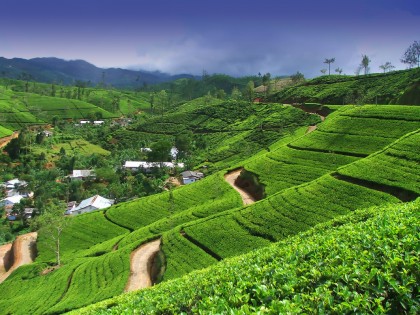 Ceylon Tea Plantation, Central Highlands of Sri Lanka The Samurai encounter Buddhist monks
The Samurai, the fierce warriors in calamitous era, honor bound to hold their lives subservient to the unwavering loyalty towards their feudal lords had assumed the Zen Buddhist monks would run for their lives at the first sight of blood. But then the Buddhist monks indoctrinated in the impermanence of all worldly matters couldn’t be ruffled from their serenity even in the face of mindless violence. The Samurai, who had been simmering with violence at all times, who had thought of the ordinary populace & monks as living testimony to cowardice, were taken aback to witness that there were means other than violence which would make one infused with indomitable courage.
Some of the Buddhist monks continued to meditate even as their temples were raging with fire & their fellow monks were put to sword. Such was the lasting impression of the phenomenon made on the Samurai, who aspired to be on par with the nobility & imperial court of Japan in terms of literary skills & intellectual faculties during the 11th & 12th centuries, took to Zen Buddhism with great fervor.
During the 13th century, upper class Samurai were already highly literate as a result of introduction of Confucianism from China during the 7th to 9th centuries. The practice of Zen Buddhism by Samurai resulted in them overcoming the fear of death & tendency towards killing at a mere whim. The 13th century also saw the formalization of Bushido, the Japanese code of conduct of Samurai warriors. In time the Samurai were to become an outstanding community among the most zealous disciples of Zen and tea.
The Samuari takes to Zen & tea
The Samurai found Zen as well as tea served a purpose in their very existence, which could be cut short at any moment in the battle if not at a mere whim of their feudal lord. Feudal lords of Japan called Shoguns developed a practice of gifting special jars of tea to Samurai for exceptional display of valor in the battlefield so that they could invite his kith & kin to a tea ceremony celebrating the occasion.
Tea ceremony begins to take shape
In time the tea drinking habit of Zen Buddhist monks was to create an extension into the wider, secular culture of Japan in the form of tea rituals. The initial incursion of tea habits into aristocratic circles of Japan resulted in evolving the order, art and simplicity in Japanese tea ceremony encapsulating the four principals of Japanese code of ethics: harmony with people & nature; respect for others; spiritual purity & tranquility.
With aesthetics of tea ceremony on ascendance, the ritual was formalized by the Shogun Ashikaga Yoshimasa in the 15th century. An everyday activity was brought up to a level of awareness that would detach all from the militarized feudal system albeit for a limited duration of the tea ceremony. Guests sat in serenity & took their own sweet time to taste & enjoy their tea in the calm atmosphere devoid of chatter & babble.
Within the confines of the tea house, all guests were put on an equal footing: nobody carried arms. Social status & military statues of the guests seized to exist: the peasant was held in the same esteem that the emperor was held. Tea ceremony was a far cry from then existing feudal system, a far cry from today’s calamitous modern world.
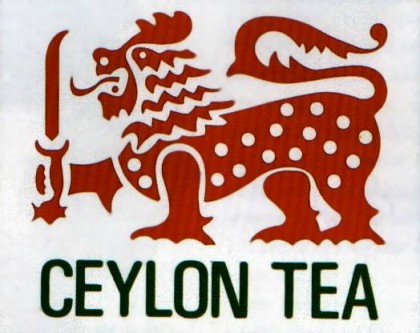 The logo of Pure Ceylon Tea, the Finest Black Tea in the World The Finest Black Tea in the World: Ceylon tea from Sri Lanka
The Finest Black Tea in the World, since the British Colonial era has come from the Indian Ocean island of Sri Lanka. Originally grown by the Scotsman James Taylor and in good time marketed by the Irishman Thomas Lipton, Black Tea of Sri Lanka came to be known as Ceylon Tea, after the British colonial name of Sri Lanka. Sri Lanka’s Ceylon Tea is grown mainly in the Central Highlands, the one and only mountain mass of the tropical island. The southern district of Galle, the district of Badulla and the district of Ratnapura too produce a considerable volume of Black Tea. Of all the tea growing zones of Si Lanka, Sri Lanka Holidays health sanatorium of Nuwara Eliya [the modern city, 1800 meters above the sea-level was founded By Samuel Baker, the discoverer of Lake Albert and the explorer of the Nile] of Central Province produces the finest of the High Grown Ceylon Tea of Sri Lanka.
Of all the Black Tea growing zones of Sri Lanka, the Central Province encompassing the Central Highlands i.e. the districts of Kandy [altitude: 500 meters] and Nuwara Eliya [altitude: 1800 meters] are largely instrumental in making Sri Lanka one of top three Black Tea exporters of the world year after year since the British Colonial era of the island.
Tags: Ceylon Tea, Sri Lanka Holidays, Tea
Posted in ~Ceylon Tea | 1 Comment »
Friday, January 18th, 2013
Location of The Kingsbury Colombo
The Kingsbury Colombo [formerly Ceylon Continental] is located in the heart of the city called Fort: at the northern end of the Galle Face Green in the immediate backdrop of the Indian Ocean to the west and Hotel Galadari Colombo and Hotel Hilton Colombo immediate to the east. Immediately to the north of Kingsbury Colombo is the Central Bank of Sri Lanka, the banker to the state.

Setting of The Kingsbury Colombo
The Kingsbury Colombo stands majestically on a strip of land nesting between the Colombo Fort marine drive called Chaithiya Road [Sinhala: Stupa Road] and the Colombo Galle A2 main road [CGHW] that connect to the Janadhipathi Mawata [Sinhala: President’s Avenue] [called Queen’s Street during the British Colonial times].
Sri Lanka Holidays Sustainable tourism (Green i.e., eco) credentials of The Kingsbury Colombo: to be edited.
Type of hotel & star rating of The Kingsbury Colombo: a five-star luxury hotel
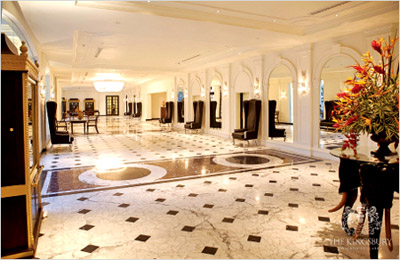
Architecture and Interior Décor of The Kingsbury Colombo
Colonial grandeur blended with luxuries of twenty first century living.
Accommodation at The Kingsbury Colombo
One Presidential suite, 21 suites & 207 luxurious bedrooms (Superior, Deluxe, Premium and Executive Rooms)
The views from the rooms at feature Galle Face Green or the Colombo harbor and Indian Ocean.
The rooms have views of the Galle Face green or the Colombo harbour and the Indian Ocean. The room interiors blends classic charm with contemporary living and are furnished with twin or king-size beds.
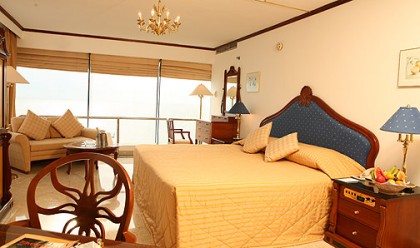
In-room facilities at The Kingsbury Colombo
All rooms of The Kingsbury Colombo are furnished twin or king-size beds
a/c, overhead fans, LCD TV with satellite channels, IDD telephone, tea/coffee facility
wi-fi internet, digital safe, room service and laundry service.
En-suite white marble bathrooms are equipped with hot water and cold water showers.
In house facilities at The Kingsbury Colombo
Ballrooms: The Balmoral, The Victorian and The Winchester.
Other hotel facilities include a swimming pool, fully equipped fitness centre, spa offering relaxing massages and beauty treatments, business centre and banquet facilities.
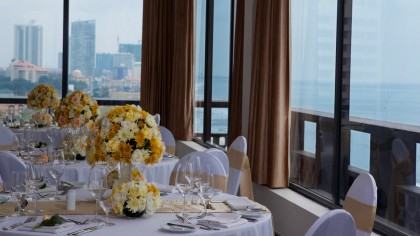
Restaurants and bars at The Kingsbury Colombo
The Ocean (world cuisine: an all day restaurant serving international cuisine for breakfast, lunch and dinner
Yue Chuan (Chinese): serves up Cantonese and Szechuan dishes
Fisherman’s Wharf: seafood specialties
The Gourmet Station: specialty teas brewed of Ceylon Tea, the finest Black Tea in the world, chocolates, cakes and pastries.
The King’s Pub, the lobby bar: a range of alcoholic beverages.
Excursions within Colombo district
Kaleniya Royal Temple at the city of Kaleniya, located 11km east of Fort, Colombo
Seemamalaka and Gangaramaya temple located 3 km south of Fort, Colombo on the eastern bank of Beira Wewa [Sinhala: Beira Lake]
Bellanwila Raja Maha Vihara [Sinhala: Bellanwila Royal Buddhist temple] at Bellanwila, off Dehiwale, 14km south of Fort, Colombo and 5km east of Sri Lanka Holidays Mount Lavinia.
Tags: Colombo, Sri Lanka Holidays
Posted in Colombo | No Comments »
|
 |

|
 |
|


























 Learn CPR and save a LIFE
Learn first-aid and save a LIMB
Learn CPR and save a LIFE
Learn first-aid and save a LIMB
